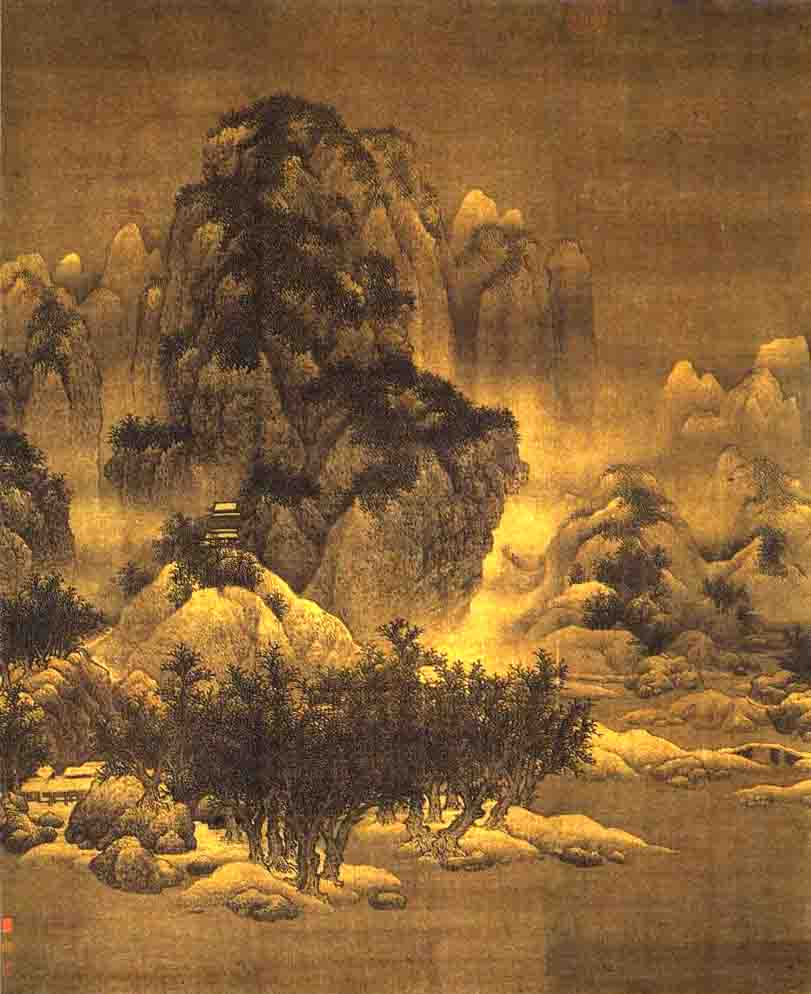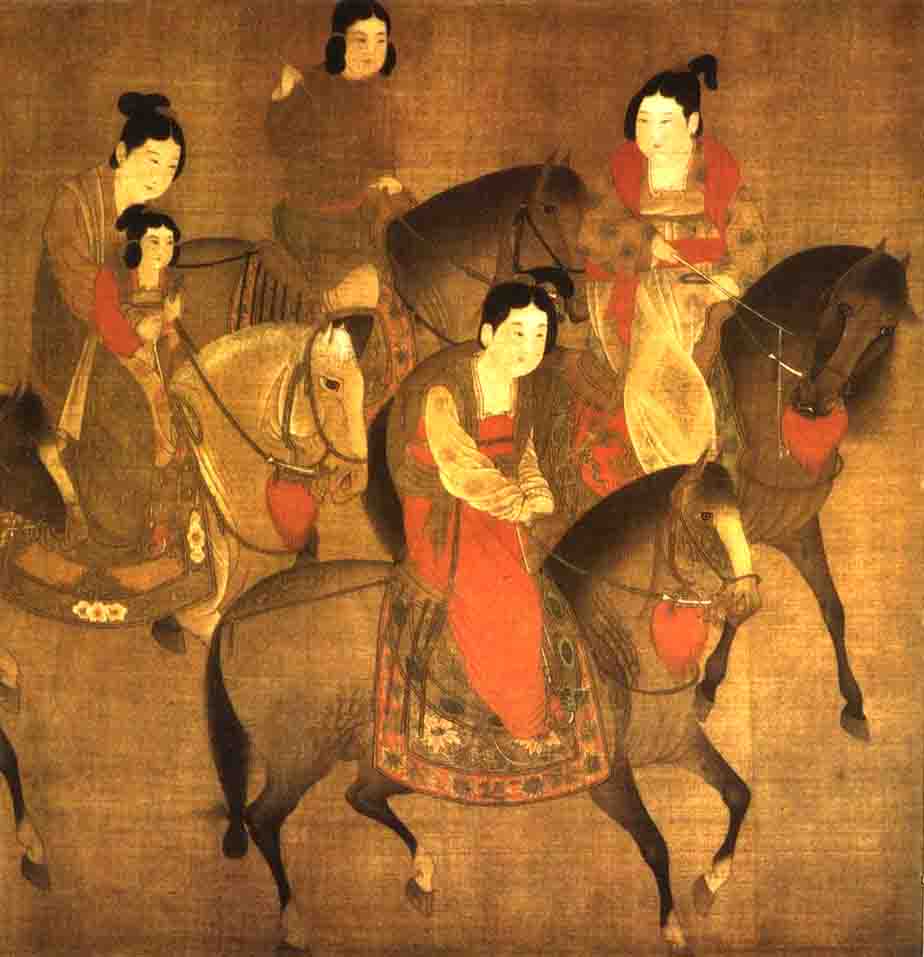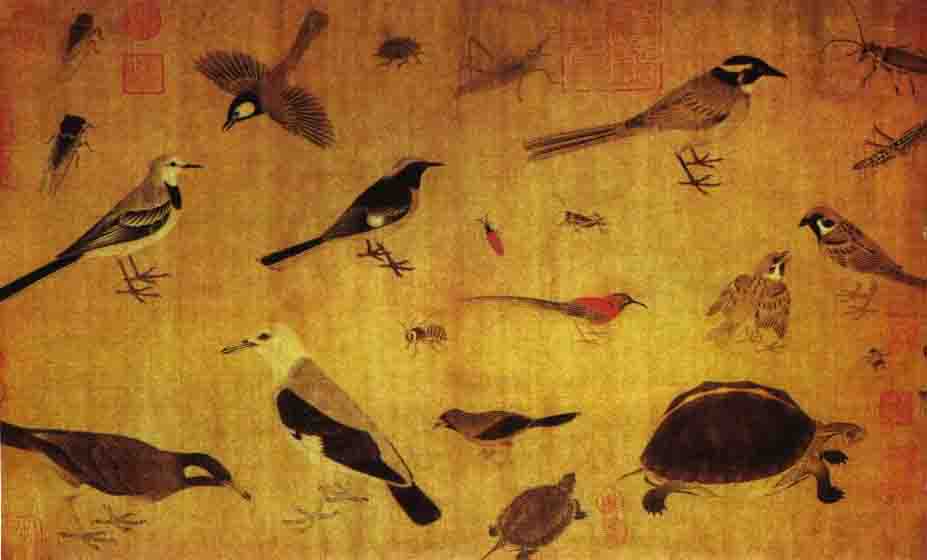|
| |
|

|
|
Classification
of Chinese Paintings
Landscape
Painting
“Landscape”
for short, paintings that mainly depict natural sceneries such as
mountains and waters.
Landscape
Painting was gradually developed during the Wei, Jin, and Southern and
Northern Dynasties, but was an auxiliary to Figure Painting, mostly as
background; became an independent genre in the Sui and Tang Dynasties,
such as the colored Landscape by Zhan Ziqian, the gold-and-green
Landscape by Li Sixun, the ink-and-wash Landscape by Wang Wei, and the
slashed-ink Landscape by Wang Qia, etc.; flourished in the Five
Dynasties and Song Dynasty, when so many painters mushroomed: the
ink-and-wash Landscape school had Jing Hao, Guan Tong, Li Cheng, Dong
|
|
Yuan,
Ju Ran, Fan Kuan, Xu Daoning, Yan Wengui, Song Di, Wang Shen, Mi Fu, and
Mi Youren, and the blue-and-green Landscape school had Wang Ximeng, Zhao
boju, and Zhao Bosu, south and north vied each other for refulgence,
thereby reached its peak and became an important genre of Chinese
Paintings ever since; came to the Yuan Dynasty, the trend went to
freehand style, let abstraction guide representation, emphasized on the
verve of ink and brush, inaugurated a new style; further developed and
innovated in the Ming and Qing Dynasties and modern times, the landscape
painting in the time was particular about composition and expression of
mood.
The
traditional classification includes forms such as ink-and-wash,
blue-and-green, gold-and-green, boneless, pale-crimson, and light-color,
etc.
|

|
|
Figure
Painting
An
appellative for paintings that illustrate human figures, “Figure” in
short, is a major genre in the Chinese Paintings, the appearance of
Figure Painting was earlier than Landscape and Flower-and bird; it’s
generally divided into Taoist-and-Buddhist Painting, Female Images,
Portrait, Genre Painting, and History-story painting, etc.
Figure
Painting strives for precise and lifelike depiction of the character’s
personality, both outlook and spirit. The representative famous Figure
Painting works of all times include <Nimph of the Luo River>
Scroll by Gu Kaizhi from the
|
|

|
East
Jin Dynasty, <the Literary Arena> by Han Huang from the Tang
Dynasty, Gu Hongzhong’s <Han Xizai Gives a Banquet> in the
Southern Tang of Five Dynasties, Li Gonglin’s <Portrait of
Vimaiakirti> in the Northern Song Dynasty, Li Tang’s <Pick the
Osmund> and Liang Kai’s <Li Bai Strolling> in the Southern
Song Dynasty, <Row Female> by Qiu Ying from the Ming Dynasty, Luo
Pin’s <Ghosts>, Min Zhen’s <Female In Banana Leaf
Shade>, and Su Liupeng’s <Drunken Li Bai> from the Qing
Dynasty, as well as modern painter Ren Xiong’s <Drinking Cards>.
In the contemporary age, Figure Painting stresses more on “learn from
the nature”, and assimilates the western techniques, has made
progresses in both modeling and coloring. |
|
Flower-and-bird
Painting
Flower-and-bird
Painting mainly depicts animals and plants, can be categorized according
to subjects as flower, feather, vegetable and fruit, grass and worm,
animal and beast, squama and shell, etc. It is considered the
representative of the uniqueness of the Chinese traditional painting in
the world, fully expresses the character and state of mind of the
Chinese people. Numerous artists of this genre emerged in the past
dynasties, such as cranes by Xue Ji, peacocks by Bian Luan, and flowers
and bamboos by Diao Guangding in the Tang Dynasty; eagles by Guo Qianhui,
flowers and birds by Huang Quan and Xu Xi in the Five Dynasties; flowers
by Zhao Chang, sparrows by Cui Bai, and flowers and birds by Wu Yuanyu
in the Northern Song Dynasty; broken branches by Wu Bing, fruits by Lin
Chun, and |
| poultries
by Li Di in the Southern Song Dynasty; bamboos by Li Kan, mandarin ducks
by Zhang Shouzhong, and plums by Wang Mian of the Yuan Dynasty;
poultries by Lin Liang, ink flowers by Chen chun and Xu Wei of the Ming
Dynasty; fishes by Zhu Da, lotuses by Yun Shouping, and birds by hua Yan
of the Qing Dynasty, as well as flowers by Wu Changshuo and worms and
fishes by Qi Baishi of the modern times, were all masters of their
times, emerged in an endless stream. |

|
中国画画科
山水画 中国画特有的一个画科,以山川自然景色为主要描绘对象。山水画在历史上的形成比人物画晚,魏晋南北朝时期主要作为人物画的背景出现。隋唐时期发展出较为成熟的画法和画理,开始成为独立画科,此间青绿山水是主流,代表人物有展子虔、李思训等,同一时期,王维的水墨山水则创造出山水画的另一种意境。到了五代,水墨山水进一步发展成为山水画中的主流,形成以荆浩、关仝为代表的北方山水画派和以董源、巨然为代表的南方山水画派。宋代是山水画史上的最高峰,杰出大师层出不穷。“北宋三大家”的李成、范宽、郭熙主要延续五代北方山水画系而气象更为宏大深远,王希孟创作出青绿山水的鸿篇巨制,南宋山水则一改北宋的全景式构图,“马一角,夏半边”是这个时期的代表。元朝的赵孟?和元四家,明朝的浙派和吴门画派,清代的四王四僧及吴、恽二家等,他们对山水画的持续发展都有新的贡献。20世纪至今,在西方绘画的冲击下,中国传统山水画发生了新的变革。
人物画 人物画是以人物为描绘主体的绘画,按绘画对象不同一般分为道释画、仕女画、肖像画、风俗画、历史故事画等,按所用技法不同可分为工笔人物和写意人物。无论古今中外,人物画都是绘画中的重要画科,但在审美追求上,中国人物画的“气韵生动”是区别于西方人物画的主要特征。人物画比山水画、花鸟画出现得更早,在周代即有劝人弃恶扬善的历史人物壁画,战国时期发现了迄今为止最早的独幅人物画,作品已具备以线条为主的画法特点。魏晋宗教画兴盛,出现了以顾恺之为代表的第一批人物画大师。唐代有画圣吴道子,创作出《步辇图》等名作的阎立本,善画仕女画的张萱、周?;五代有《韩熙载夜宴图》的创作者顾闳中;宋代有《清明上河图》的张择端,有擅长风俗画的苏汉臣、李嵩,有开创减笔画的梁楷,元朝有颜辉、刘贯道,明清有陈洪绶、曾鲸,这些人都是人物画家中的佼佼者。现代人物画吸收了西洋技法,结合时代特征,正在进行前无古人的尝试。
花鸟画 花鸟画以描绘小动物和植物为主,其“花鸟”是一个宽泛的概念,除了本意花卉和禽鸟之外,还包括了走兽鱼虫等动物,以及树木蔬果等植物,花鸟画是中国绘画门类中特有的一种绘画画科,集中体现了中国人和自然生物之间的审美关系。魏晋南北朝时花鸟画已逐步形成了独立的画料,到了唐代渐趋成熟。五代是中国花鸟画发展史上的重要时期,以徐熙、黄筌为代表的两大流派体现了两种不同的花鸟画特征。北宋的赵昌、崔白,南宋的林椿、李迪在工笔花鸟上都卓有成就,而苏轼、文同等人倡兴的梅兰竹菊水墨花卉,则成为后世文人画最流行的题材,如元代画梅的王冕即受其影响。明代白阳青藤派画家陈淳和徐渭擅长写意花鸟画,到了清代,八大山人以其独特的绘画语言在花鸟画史上留下重重一笔。近现代许多名家如齐白石、徐悲鸿、林风眠、吴冠中等,在花鸟画上都有独到的创新。 |
|
|
|
|